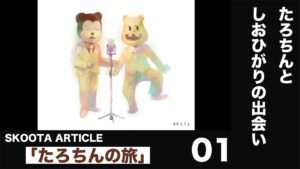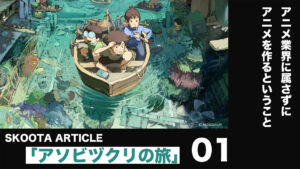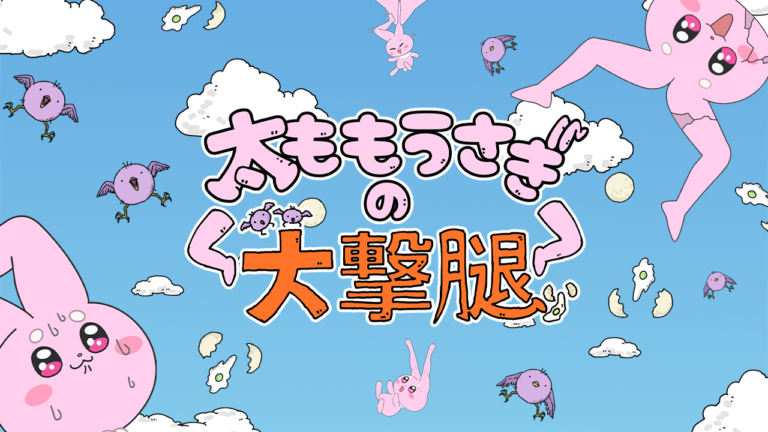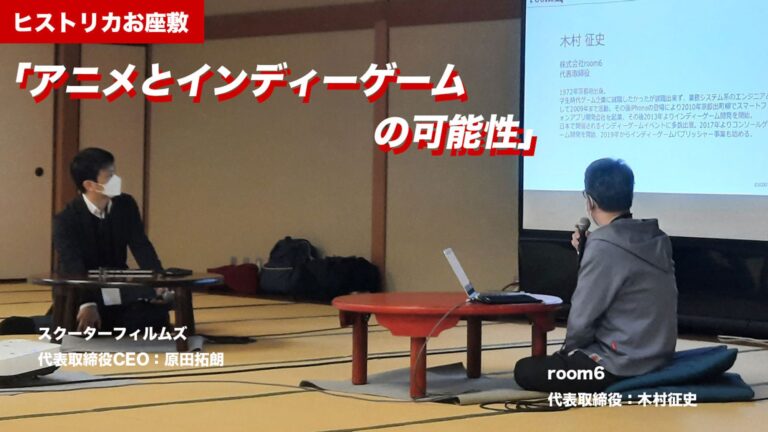This article can be listened to as a podcast on the following media.
Guests and Personality
Guest: Asobizukuri
Founded in 2018 in Tokyo by planner and marketer Akihiro Yamamoto and writer Kentaro Shimoda, this animation team focuses on the theme of “extending play by creating play.” Their creativity is characterized by innovative ideas combined with meticulous technical skills, reflecting a playful spirit and deep thinking.
Akihiro Yamamoto
Planner and marketer
Born in 1998, 25 years old
After graduating from high school, he joined an animation company as an animator but was fired after about a year due to lack of skills. He later met Shimoda on Twitter, and they began creating independent animations together, although their first project fell through. During this time, he started participating in sketch meetings to expand his network. The sketch doujinshi he published became a hit, and he is currently making a living from it while producing independent animations.
Kentaro Shimoda
Animator and writer
Born in 1997, 26 years old
After graduating from a part-time high school, he worked part-time at Yamazaki Baking Company while wandering around. During this time, he met Yamamoto on Twitter. While drawing together in Inokashira Park, they hit it off and decided to turn their drawings into an animation, marking the beginning of their serious activities.
Personality: Yuki Sakoda
After working at a telecommunications company and a general advertising agency, he founded an animation planning and production company, producing videos from music videos to films. In 2021, he moved to Kyoto and began working to revitalize the entertainment industry there. Recently, he has also been involved in the manga and audio entertainment fields, currently planning and producing audio dramas and webtoons. Additionally, he serves as a producer and advisor for several entertainment companies.
Overall Table of Contents
#01
・Yamamoto started as an animator but…
・The connection between Yamamoto and Shimoda on Twitter
・A town of junk filled with childhood dreams
・Consumption of fantasy works
・Inspired by Summer Wars to aim for the animation industry
・Shimoda drawing while working part-time
・Creating animation without belonging to the animation industry
・Conflict regarding the length of animation
#02
・The motivation behind wanting to create independent animation
・The sketch meetings of the two in Inokashira Park
・What they felt while trying to create animation in the industry
・High risk, low return
・The balance provided by Shimoda’s sketches
#03
・What does play mean to the two of Asobizukuri?
・Things they can immerse themselves in
・Understanding structures
・Gaining the physicality of objects through sketches
・Creating a space where play can happen
・The stories that Asobizukuri envisions
The Motivation Behind Creating Independent Animation
Sakoda
This is a brief recap, but in Episode 1, I introduced the two from Asobizukuri and discussed how they met, while also moving towards the current situation where they are creating independent animation. During this, I learned that there was a significant disagreement between Yamamoto and Shimoda regarding the length of their first work.
Discussions about length and duration only arise when one is conscious of “video,” but when it comes to animation or video, one must discuss “what they want to convey” along a timeline. In Episode 2, I would like to ask about their new independent animation project, titled “Garakuta Town” (tentative), and the reasons behind their choice of independent animation, what they want to achieve now, and what they hope to do in the future. How does that sound?
Yamamoto
Regarding why we chose independent animation, it wasn’t a deliberate start. Shimoda saw a drawing I posted on my LINE timeline, which depicted children playing in a secret base. He suggested, “Let’s draw an improved version of this together in the park.”
So, we tried to draw, but I couldn’t do it. Then Shimoda said, “Let’s play pretend and create a secret base in Inokashira Park.” We started making various secret bases and eventually Shimoda said, “We should turn this into an animation.” So, we decided to go for it, and it all started quite accidentally without any specific reason.
As the project began, I started to think about the value of creating independent animation and various strategic aspects began to accumulate, so it became more than just a coincidence.
Sakoda
So, you were actually drawing together in the park?
Yamamoto
Yes, that’s right.
Sakoda
That sounds like a really heartwarming scene. But that’s how it all begins, right? You think, “This is interesting.” Since you’re next to each other, you can say, “Oh, that drawing is nice,” right?
What I wanted to ask is, drawing is essentially a form of static creativity. I think there needs to be a significant reason to want to turn that into animation. Animation creates a timeline by stringing together consecutive images, which gives rise to a story. There are also other vectors like adding music or voice, but animation is a medium that can encompass all of that, which means there are many things to consider.
There are many emotional and rational reasons for the two of you to jump into creating animation at this time, and I would like to hear about both aspects.
Yamamoto
When we were playing “secret base building,” we were drawing the secret base on the ground with sticks, like a floor plan. The secret base had a shape like an animal and went slightly underground. After enjoying building the secret base, we realized we couldn’t capture its charm in a single drawing. To express the allure of the secret base, we needed animation to show various angles, sounds, and the atmosphere. Shimoda started saying this, and I was thrilled to go along with it.
Sakoda
I see. What was Shimoda’s feeling at that time when he wanted to do that?
Shimoda
While drawing, the image started to expand. Various rooms and places were created, and as Yamamoto said, it was hard to fit everything into a single drawing. Since Yamamoto was already doing animation, I thought, “Maybe we can show it through animation.” When I usually draw, I don’t capture everything, but I do try to depict parts that aren’t usually shown. I thought, “If it’s animation, can’t we show everything?” and that’s probably when I made the suggestion.
Yamamoto
There wasn’t a grand reason when we started.
Sakoda
By the way, how many years ago was that?
Yamamoto
About six years ago?
Sakoda
You’ve been running with this for six years now. How do you feel about choosing animation?
Shimoda
Choosing animation has its challenges, and through our activities, I’ve realized my abilities and encountered various frictions. But I think no matter what you choose, there will be enjoyable and painful experiences. Currently, I’m enjoying what I’m doing, so I feel it was a good choice. How about you, Yamamoto?
Yamamoto
I don’t have much of an opinion. I don’t have a philosophy regarding visual expression, and I approach it more intuitively, thinking, “I can express more with video than with a single drawing.”
Also, when it comes to drawing, I feel stressed when I have to draw the same kind of picture repeatedly, but Shimoda seems to enjoy that process without any stress. So, in terms of animation production, I don’t feel much cost or regret.
Sakoda
At least continuing for five or six years means that if you were working with members who didn’t fit or dealing with themes you didn’t want to tackle, you wouldn’t last that long. By the way, I’ve been working on a long feature film project since around 2017, and I’ve realized that for a director or central figure who wants to create a work, they must be deeply passionate about it, to the point of wanting to dedicate their life to it. Otherwise, it wouldn’t last five or six years, and you can’t continue with people you absolutely dislike. So, I think the needs of both of you matched well.
For example, Yamamoto wanted to create a world through animation, but he felt he couldn’t just keep drawing the same pictures at an animation company. Shimoda might not have aimed for animation, but he sought to create something with like-minded companions. In that context, while Yamamoto finds it tough to draw a lot, Shimoda doesn’t mind it, and they both share themes like summer memories and childhood dreams, which led them to start this journey. The fact that it has continued for five or six years suggests that their needs fit together very well.
By the way, what kind of movements were you observing in the independent animation scene five or six years ago?
Yamamoto
What was it? “Fumiko’s Confession,” right?
Sakoda
Yes, by Yukan Ishida.
Yamamoto
When I was in high school, I searched for animation production on YouTube and thought, “Wow, that’s amazing.” At that time, there wasn’t the same level of excitement as now. It felt like, “Well, it’s something students create, right?”
Shimoda
Yes, sometimes you would find something made by art university students as their graduation project on YouTube.
Yamamoto
It was like a few graduation projects from animation departments popping up here and there.
Sakoda
That’s right. Five or six years ago, it was mostly works made by art university students, and there were platforms like ICAF for student animation film festivals where they would showcase their work as a grand finale. But now, individuals are working on music videos and gathering through hashtags, and the scene has really come alive in the past few years.
Five or six years ago, the output of independent animation wasn’t at a peak, but for the two of you, it seems like you were a bit ahead of the curve in deciding to create independent animation.
Yamamoto
That’s right. After trying to create animation in the industry, I felt constrained sitting at the same desk every day. The animation industry has fixed frameworks regarding salaries and working conditions. I dabbled a bit in production management, and seeing all that made me realize there was no need to create within the animation industry. Nowadays, you can release animations on social media, and with events like Comiket, individuals can monetize their work.
So, without needing to create a production committee, individuals can create animations and aim for monetization. However, that requires a lot of talent and effort, but I thought, “With Shimoda’s talent, we should be fine.” Various pieces fell into place, and we decided to take on independent animation. Plus, YouTubers were starting to gain popularity, and their status was becoming established.
Six years ago, while independent animation was being released, talented individuals often entered the animation industry and then became untraceable as they blended into it. They might be thriving, but it felt like their works were just business cards. I sensed that we were entering an era where we could directly create our own productions rather than just independent ones. Additionally, at that time, there were discussions about the black issues in the animation industry, which could take a long time to explain. The animation industry felt like a low-risk, low-return field.
Shimoda
Were you working as an animator in an animation company?
Yamamoto
Even if you gather funds through a production committee to create animation, you don’t hold the rights, and the production costs aren’t necessarily generous. Compared to other industries, the production committee system is not fully understood, but generally, entertainment sells if it hits, and if it doesn’t, it doesn’t sell. If one company takes on all the risks and fails, that one project could lead to the company’s collapse. To mitigate that risk, the production committee system was created to share the burden, allowing companies to continue regardless of whether a project is a hit or not.
However, due to low production costs and tight schedules, while it is low-risk, it can be high-risk in the long term. For example, when I become a grandfather, it seems like it would be very tough. A hardcore craftsman might find happiness in that life, but I wasn’t that kind of craftsman. I could push myself for a month, but thinking about continuing that for decades made me feel it wouldn’t be sustainable. I forgot the context of how we got here.
While it is low-risk and low-return, in the long term, it might actually be high-risk when viewed over a lifetime. I thought that being deeply immersed in such a field could be high-risk, so I considered that it might be better to pursue a clear high-risk, high-return approach through self-production. At that time, there wasn’t much enthusiasm for independent production, but when I opened Twitter, I saw discussions about the black issues in the animation industry, with calls to “change the upper management.” However, I felt that changing the industry structure wasn’t just an upper management issue; it was a problem that involved everyone from top to bottom. Therefore, while it is difficult to change, if we could make a living outside the industry, it might lead to a natural evolution of working conditions, which could ultimately change the industry.
From a business perspective, it could also be a positioning opportunity. The independent animation industry is likely to grow, and we could position ourselves as pioneers in that field. All these thoughts connected in various ways, and I ended up not knowing where to land.
Sakoda
It seems like a trivial trigger, but I could really feel the experiences Yamamoto had while being close to the animation industry, and it naturally came out in his words. I didn’t enter the animation industry, but from the outside, I observed similar thoughts when I started creating animation, so I felt a strong sense of understanding. It’s not just about wanting to improve a single work; it’s about looking at the entire industry layer and considering what happiness and unhappiness mean over a long span of a person’s life. There are clear distinctions between those who think about these things and those who don’t.
This isn’t a matter of good or bad, but you can live your life without thinking about various possibilities. In a way, craftsmen focus on one thing without considering various possibilities. I tend to want to think about many things and make judgments from various perspectives, so I have a personality that can’t help but think. Perhaps Yamamoto also had seniors who said, “It’s pointless to think about that,” but he thought, “No, that’s not right,” and he was able to think and execute various ideas, which I found very insightful.
As we pass the baton to the second half, do you have a song in mind?
Shimoda
Can I suggest one? Please play “Easy Breezy” by chelmico.
The Balance Provided by Shimoda’s Sketches
Sakoda
Yes, you just heard “Easy Breezy” by chelmico. Do you have any stories related to this song?
Shimoda
It’s not a story about the song itself, but during the time when we were saying, “Let’s do independent animation,” I found a manga called “Keep Your Hands Off Eizouken!” which features characters like us who are actually creating independent animations. Reading it really fired me up, which is why I chose this song.
Sakoda
That’s great. “Eizouken” really resonates with those who create their own original works, as it reflects the joy of making what they love. If I may interject, I started a project called “Kurayukaba” with director Shigeyoshi Tsukahara around 2017, initially involving crowdfunding. By the way, the motif of going deeper into a cave that Shimoda mentioned earlier is very similar to “Kurayukaba.” At first, Tsukahara was creating setting materials with a lot of passion, and we thought, “Let’s give it a try,” even though we weren’t sure how it would turn out.
During that time, we were making small moves, like creating a PV and increasing the setting materials, while also launching crowdfunding. Around the time we initiated the crowdfunding, we held a small event, and at that event, Sumito Ōmori from “Eizouken” was a guest. It turns out Ōmori had seen Tsukahara’s work before.
Shimoda
What a connection…
Sakoda
Yes, I feel a strong connection there. I can really sense the same underlying spirit in the works of Asobizukuri. Returning to what Yamamoto mentioned earlier, everything he talked about seems to connect. The writings on Asobizukuri’s pixivFANBOX also reflect Yamamoto’s feelings about the working environment of creators, including producers and production staff, viewed over a long-term span as a high-risk, low-return situation. They express a desire to correct that and suggest alternative ways of working, emphasizing that there isn’t just one way to create.
Just like Ishida Yukan, who creates amazing works as an individual, it makes you think, “Why can’t we do this outside of a studio?” When I actually ran a studio and created long works, I understood both the things that can only be done in a studio and the studio’s merits. It’s not about which is better or worse, but the possibilities have expanded with the proliferation of digital tools and the increase in platforms for release. I think it’s perfectly fine to approach and challenge those possibilities.
While pursuing those challenges, the topic of monetization that came up might not have been anticipated, but by publishing the sketch book, it has become a source of revenue to sustain their activities. So, they are already realizing the idea of creating animation funded by other revenue sources without any pressure, at their own pace, which is impressive.
Yamamoto
Yes, that’s about right.
Sakoda
I want to delve into something briefly here. In your pixiv writings, you mentioned, “We are challenging whether we can compensate for the low turnover rate of small-scale projects by turning the production process into content.” This seems to relate to the idea of publishing the byproducts and thoughts that emerge during the production process. I think many creators are curious about this sketch book, so I’d like to hear what you can share about it.
Shimoda
Yes, it’s not that we’re publishing what we gained from independent animation, but since I do a lot of sketching, I thought I could turn my sketchbook and drawing techniques into something useful, which led to the idea of creating a book. How should I put it… but it turned out to be really good.
Yamamoto
Right. When it comes to making money, you need to have some kind of product or service. Turning animation into a product is quite challenging, and you need to prepare funds for that. In that sense, the sketch book was a perfect fit and a blessing. At that time, I didn’t even have an iPad, and when I decided to create animation, I had to get a tracing board from someone I didn’t know through a flea market app, and I gathered paper in various ways to create analog works.
However, creating analog works takes a lot of time and effort, so I thought I needed to buy an iPad. But at that time, both Shimoda and I were working part-time jobs, and I wasn’t working full-time, so I couldn’t afford to buy an iPad while living. So, I thought about how to get an iPad Pro. The first sketch book I published was a collection of Shimoda’s sketches, created without incurring production costs. I launched a crowdfunding campaign, but since they take fees, I gathered printing costs online and collected money directly through Twitter and bank transfers to create one book. That way, I managed to earn enough to get an iPad, and it supported the overall flow of our activities.
Independent animation isn’t something you can easily release into the world, so if you stay cooped up, you lose connection with society and the outside world. But with Shimoda’s sketches, we could publish a book, and people bought it, allowing us to participate in the economy. The sketch meetings also helped maintain our balance, connecting us with others. In that sense, I’m really glad we did it.
Shimoda
That’s true.
Sakoda
One issue that comes with choosing animation as a form of expression is that the products we create have overwhelmingly low opportunities to be showcased. I often use the term “at-bat” because I like baseball. In film, it feels like you get one at-bat every four or five years. Of course, since it’s a film, not everyone gets to bat, so if you hit a home run, it might score high, but the reality is that “one at-bat in five years is tough.”
In that context, if we can transform the byproducts that arise during the process of creating visuals into products, we can have many more opportunities to showcase our work. So, even if Yamamoto and Shimoda are creating animation, they can sketch a lot and compile those sketches to sell them, which has turned out to be a great success.
This is a fantastic example of success, and I think it’s a brilliant strategy. However, one point to note is that because we are creating original works, the scope of what we can do is virtually limitless. When collaborating with someone, particularly with capital, the best scenario is when that capital doesn’t impose restrictions. But that’s not always the case, and I think Yamamoto might have felt some of that suffocating pressure while working in the animation industry.
I’d like to hear more details in the next episode.
#03 continues

![[Tarochin’s Journey #02] Connecting to the Internet from Dreamcast](https://skoota.jp/media/wp-content/uploads/2024/06/talklogたろちん_02-300x169.jpg)




